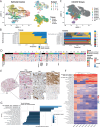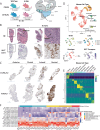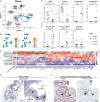Convergent alterations in the tumor microenvironment of MYC-driven human and murine prostate cancer
- PMID: 39198404
- PMCID: PMC11358296
- DOI: 10.1038/s41467-024-51450-2
Convergent alterations in the tumor microenvironment of MYC-driven human and murine prostate cancer
Abstract
How prostate cancer cells and their precursors mediate changes in the tumor microenvironment (TME) to drive prostate cancer progression is unclear, in part due to the inability to longitudinally study the disease evolution in human tissues. To overcome this limitation, we perform extensive single-cell RNA-sequencing (scRNA-seq) and molecular pathology of the comparative biology between human prostate cancer and key stages in the disease evolution of a genetically engineered mouse model (GEMM) of prostate cancer. Our studies of human tissues reveal that cancer cell-intrinsic activation of MYC signaling is a common denominator across the well-known molecular and pathological heterogeneity of human prostate cancer. Cell communication network and pathway analyses in GEMMs show that MYC oncogene-expressing neoplastic cells, directly and indirectly, reprogram the TME during carcinogenesis, leading to a convergence of cell state alterations in neighboring epithelial, immune, and fibroblast cell types that parallel key findings in human prostate cancer.
© 2024. The Author(s).
Conflict of interest statement
The authors declare no competing interests.
Figures








Update of
-
Convergent alterations in the tumor microenvironment of MYC-driven human and murine prostate cancer.bioRxiv [Preprint]. 2023 Oct 17:2023.09.07.553268. doi: 10.1101/2023.09.07.553268. bioRxiv. 2023. Update in: Nat Commun. 2024 Aug 28;15(1):7414. doi: 10.1038/s41467-024-51450-2. PMID: 37905029 Free PMC article. Updated. Preprint.
References
MeSH terms
Substances
Grants and funding
- U54CA274370/U.S. Department of Health & Human Services | NIH | National Cancer Institute (NCI)
- P50 CA180995/CA/NCI NIH HHS/United States
- P50 CA058236/CA/NCI NIH HHS/United States
- P30 CA006973/CA/NCI NIH HHS/United States
- U01 CA196390/CA/NCI NIH HHS/United States
- P01CA247886/U.S. Department of Health & Human Services | NIH | National Cancer Institute (NCI)
- P50CA058236/U.S. Department of Health & Human Services | NIH | National Cancer Institute (NCI)
- P50CA180995/U.S. Department of Health & Human Services | NIH | National Cancer Institute (NCI)
- U54 CA274370/CA/NCI NIH HHS/United States
- P01 CA247886/CA/NCI NIH HHS/United States
- U01CA196390/U.S. Department of Health & Human Services | NIH | National Cancer Institute (NCI)
- W81XWH-19-1-0450/U.S. Department of Defense (United States Department of Defense)
- P30CA006973/U.S. Department of Health & Human Services | NIH | National Cancer Institute (NCI)
LinkOut - more resources
Full Text Sources
Medical
Molecular Biology Databases

